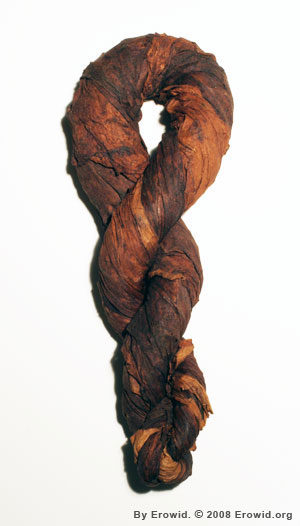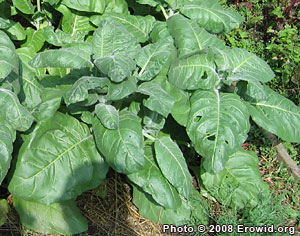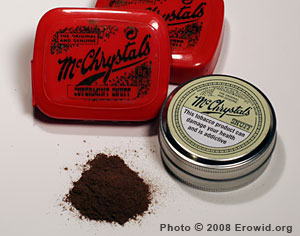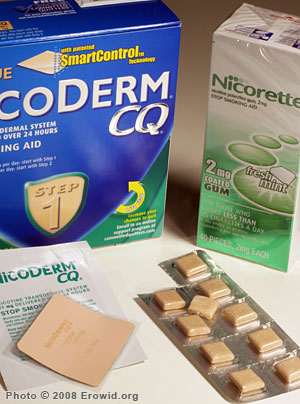Varieties of Nicotine Experience
Uncommon Uses of Tobacco and Nicotine
v1.0 - Nov 2007
Citation: Spoon (ed). "Varieties of Nicotine Experience: Uncommon Uses of Tobacco and Nicotine." Erowid Extracts. Nov 2007;13:4-8.

|
While tobacco is now viewed as a public health menace in industrial societies, it is considered the principal plant ally of traditional shamans throughout the Americas. Consequently, the visionary properties of unprocessed tobacco leaves are sometimes romanticized--although infrequently explored--by non-indigenous psychonauts. And yet, while the use of large doses of tobacco for ritual purposes was certainly a part of native life in North America, heavy, chronic use that might be characterized as dependency by modern standards was equally evident in some tribes.1
The visionary properties of unprocessed tobacco leaves are sometimes romanticized — although infrequently explored — by non-indigenous psychonauts.
Given the pervasive stereotypes surrounding cigarette smoking and other forms of tobacco use, it can be difficult to find a meaningful way to use nicotine specifically for its consciousness-altering properties. We've collected some examples below that illustrate different approaches to tobacco and isolated nicotine, some radically removed from more common forms of use.
- Von Gernet A. "Origins of nicotine use and the global diffusion of tobacco". In: Ferrence R, Slade J, Room R, et al. (Eds.). Nicotine and Public Health. Am Public Health Assoc. 2000. 3-15.
An Uncured Variety of Tobacco, by Kleineskind
I have been reading about many different legal types of medicinal herbs. I felt rather compelled to test a few out. My first mix was that of uncured tobacco and catnip.I read that the Native Americans smoked uncured tobacco, so I wanted to try it. I live in the middle of farmland and get free stock all the time; this season, I asked for uncured tobacco. I let it dry in my closet (dark, dry environment) and got both a pipe and papers to test the different effects of the heat in a pipe compared to the heat in a joint.
With 2 g of uncured tobacco in my stone pipe, I noticed a bit more effect than I would expect from normal tobacco.... It was not potent enough to cause unconsciousness after as little as a cigarette, as I had read it could be. It made me a bit lightheaded, as normal tobacco or cigarettes would, but nothing too out of the ordinary. The slight euphoric feeling subsided quickly.
1.5 g of uncured tobacco in my papers: Not very different from the experience with my pipe. I did get knocked with a quicker delivery of the drug, but, as before, it subsided rather quickly. I tried a lot of mixing with catnip. The more catnip I put into the mix, the slower the onset of the euphoria. I did notice that the hyperactivity and uneasy feeling lasted longer with the tobacco alone.
My conclusion on the matter of uncured tobacco is that it was quite unimpressive. It is not as powerful as I had read it to be. Now, it could be the variety of tobacco. There are a lot of variations to this plant, and the Indians may have used a specific hybrid different than what I was given.
Rustication: Smoking Nicotiana rustica, by Formerly Cheebo

|
I inhaled the heavy smoke, and immediately wished it was cured and moist pipe tobacco. It burned intensely, and was far, far too hot. It gave me terrible tongue-bite, and burned all the way down. However, the taste itself was not bad. It was reminiscent of cigars and had an unrefined leafy sweetness. I continued to inhale and quickly noted that my chest hurt a lot, not from the hot smoke, but from something else. It was the exact same sensation I get from having acute bronchitis and coughing a lot. It went away, however, and another feeling came on.
I began to feel a blissful clarity, an acuity that I had never felt from tobacco before. I looked around me, up into elm branches and the wispy cirrus clouds in the sky, and was pleased. Everything was more real, and very nice. My vision was "larger" and brighter. I also became a little nauseated, but I think water would have helped with that. I got on the rope swing that hangs from the elm and enjoyed life quite a bit for a few minutes. The blissful clarity subsided rather quickly, but it is conducive, I think, to a mindset that could be very good, at least if used in moderation.
Tobacco has never made me feel like this before. I think regular tobacco could do it, but it would be hard (for me, at least) to inhale enough smoke from regular tobacco fast enough to get to this state. We started out with N. rustica by making fun of it, but it is a very special, powerful herb, and I am glad I've experienced it.
Transdermal Tobacco in Psychedelic Sessions, by K.
I have been taking mushrooms in the context of psychedelic therapy every few months for the past two years. During sessions, my therapist will sometimes rub tobacco leaves on my skin if I seem to need a shift in the trip. At first she uses it on pulse points and does some energy work with me. To get to the next plateau, or if I am "stuck" in a difficult place or getting too spacey, she rubs it on my skin, usually my arms, sometimes in conjunction with bodywork. It isn't specifically for grounding or for lightening the trip; it can go in either direction, depending on what she thinks I need.The tobacco she uses is prepared by the Mazatec shaman with whom she works, who grows the plants herself or buys them from people she knows. The shaman works extensively with different types of tobacco plants. The leaves my therapist uses are either small individual leaves or shredded leaves that are bright green, dry, and soft. They roll up as she rubs them on me, and they don't transfer their oils to my skin, which at first surprised me because I thought of tobacco as having many tars and dyes, even in its natural form.
The smell is really nice, not like burned tobacco at all. Sometimes she does burn it, for smudging, but we don't smoke or eat it.
It's hard to really put my finger on how the experience is changed by using tobacco, because it's so subtle and everything else is happening at the same time, from the effects of the mushrooms to the physical interaction with the therapist. It engages the trip with a quickening feeling as it's rubbed on, a kind of looseness, as if stuff is moving from one side of the body to the other.
Taking Deep Lungfuls of Straw Cigarettes, by Marcosbj
I don't smoke commercial cigarettes and never will, because: 1) I'd rather spend my money on cannabis or save it for salvia, and 2) I don't like the smell very much.I actually hate regular cigarettes, so I don't smoke at all when sober, only when I am really drunk. But I love "straw cigarettes". I'm not sure if they are available in the United States, but here in Brazil they are quite common. There are some commercial brands, but the real thing comes from the Brazilian peasants who live in the countryside. They roll it themselves (using strong rolled tobacco and corn straw) and smoke it while drinking cachaça (a hard liquor made from sugarcane, the Brazilian version of vodka or sake).
Since I love the native culture, I like to follow it…but in a different context. Sometimes I drink a couple of beers and some cachaça. When I feel that I am under the effects of alcohol (but not drunk) I smoke a straw cigarette (regular cigarettes work as well but smell bad) for three or four puffs, then I let it go out. Since I don't usually smoke, and the tobacco in these cigarettes is strong, I feel the nicotine very strongly.
I start feeling light, then dizzy, then as if I'm floating. At this point I walk a little bit and begin to feel as though I'm flying. I repeat this a few times during the night and when I no longer get strong effects, I abstain for three or four months until I have another drinking night.
I really like the feeling. If you have access to strong tobacco cigarettes, try it, but don't smoke too much. It's addictive and the good effects are only there if you smoke a few puffs at infrequent intervals.
Homemade Ambíl from Nicotiana tabacum, by Pappa
I followed a method of preparing ambíl, the South American lickable tobacco preparation, reported in the book Tobacco and Shamanism in South America by Johannes Wilbert.I took approximately 10 medium (20 cm length) tobacco leaves from my Nicotiana tabacum plants, chopped them into strips and put them in a large pan with enough water to cover them. I brought the pan to a boil and simmered for two hours, adding more water at the 90-minute point to keep it from boiling dry.
While they were simmering, I tried to prepare alkaline ash of B. caapi bark by burning it with a blowtorch. Unfortunately, it was converted to charcoal rather than white ash, and the resulting water steeped in it was pH neutral. I then prepared some ash from chillum charcoal and obtained a pH 9 alkaline solution. This alkaline ash solution is unnecessary, as you can use sodium bicarbonate, but I was interested in trying a more traditional method.
Once the pan was cool, I took out the leaves, squeezed all the liquid out into the pan, and discarded the leaves. Then I transferred the tobacco water to a smaller pan and boiled it vigorously until there was only a 6 mm depth of liquid in the pan. The heat was then turned down and the liquid gently simmered and blown on to aid evaporation.
Eventually, only about 30-40 ml of very dark brown liquid remained. While holding the pan at a 45º angle, approximately 30 ml of alkaline ash solution was added to the liquid, followed by a quarter-teaspoon of baking powder. This made the liquid froth immediately. After frothing, much of the liquid had coagulated on the angled bottom of the pan and was thick and dry; the rest was still in liquid form. After very gentle heating of the liquid, and much scraping of the coagulated stuff, I ended up with a half-teaspoon of very thick and sticky Marmite-like material that I put into a snuff box. The final result was a little thicker than I would have liked, but from what I have read, well within the bounds of what can be described as "genuine ambíl".
A little while later, I and two others tried the ambíl, using amounts about the size of two grains of rice each. One said she felt nothing more than a strange tingling in the hands and a slightly restless feeling. The second person and I both agreed we could feel a pronounced sense of restlessness and vaguely amphetamine-like stimulation. I could also feel my heart pounding, and definitely felt on edge.
The whole experience felt a bit like an adrenaline surge, fairly mild and more or less pleasant. Subjectively, it lasted about 30 minutes. It certainly felt nothing like a "first cigarette of the morning" tobacco rush.
Maintaining Addiction, with Tobacco Snuff, by Nico
I've never been much of a fan of nasal drug administration because I've always had the idea that snorting in and of itself was a negative act, and it looked bad, especially in public. However, my friends had some minty snuff with them, and being a nicotine addict (cigarettes), I gave it a try. I liked it so much, I ordered eight different flavors of McChrystal's snuff to experiment with: rose, bergamot, lemon, menthol, eucalyptus, spearmint, violet, and camphor.

|
Nasal snuff packs quite a punch. I take a pinch between forefinger and thumb, and either lay it out on the back of my hand or make a little line on a flat surface, then introduce it into the nostril. I don't do this particularly slowly, but if done too quickly it feels like inhaling an arrow that awkwardly points out of my ear, or a sharp, burning ache in the sinus that oddly seems to come out of a random point in my head. Twenty to thirty seconds later, the uncomfortable feeling subsides and the nicotine buzz captivates my senses.
Fruity or floral snuffs usually tend to sting inside the sinuses for the first few times. Also, the nose can become a little runny and stuffed up if too much snuff is inhaled in a single sitting. Breathing through the nose is amazing after taking mentholated (also known as medicated) varieties, because it clears the upper respiratory passages and it feels like my internal air conditioning was suddenly turned on to a cool refreshing mode. I have found it my predilection to use cool snuff for everyday use, and the sweet, perfumed, aromatic snuff for special occasions and nighttime.
I've been a cigarette smoker for six to eight years now and have experienced negative side effects impairing my physical performance, endurance, and dexterity. Coughing in the morning, being easily exhausted, general slowness, and aversion to physical activity have constantly reminded me that I shouldn't smoke because it increases the risk of cancer and mid- to old-age health disorders. Ever since I started using nasal snuff, my craving to smoke has diminished by 90%. Where I would smoke half a pack to a pack of cigarettes a day, I rarely smoke more than a single cigarette anymore!
While other forms of tobacco carry their own health risks, I believe the majority of carcinogens introduced by tobacco products accompany combustion; tobacco smoke is oily and sticks to the walls of the lungs. Snuff has helped me maintain my addiction to nicotine while reducing the problematic physiological side effects of smoking. I am almost certain my dosage of nicotine has increased since I started using snuff, but I feel very comfortable with its powerful, aromatic effects, whereas I would feel endangered by health issues related to smoking. I am slowly regaining my physical endurance and vitality, and feel that while nasal snuff can be regarded as a nasty habit, it has greatly contributed to an improvement in my health overall.
A New Person wtih Nicotine Gum, by Expers

|
In the past two months I discovered nicotine gum (Nicorette). It's everything I could have hoped for. It provides me with the buzz and calming effects, which seem to last days afterward, without any fear of major health problems or stink. It's also much cheaper than cigarettes. I usually buy the 4 mg gum and cut it in half; not as much fun having less gum to chew, but it provides the same hit. The 2 mg gum really seems like a money-grab; they even specifically warn on the 4 mg gum package not to cut it in half, as if there's some valid medical reason for this. I feel like it's given me a throttle to control both mind and body energy levels. I can instantly shift gears to new highs or lows. That power has had a very "normalizing" effect on me: I'm typically a very low-energy body, high-energy brain person, which accounts for my laziness and depression (a consequence of over-thinking). The nicotine seems to slow down my mind, turning off the lingering thoughts that cause so much anxiety and depression while at the same time speeding up my body, giving me newfound stamina and strength.
I still fear addiction and tolerance. I've been intentionally keeping my dosage down to 2 mg in the morning, and sometimes 2 mg at night, taking days off here and there. I'm not sure how this will work in the long run, and whether addiction is unavoidable with regular usage or not. However, I think it is a fair price to pay for this marvelous drug. Also, the nicotine gum has the added advantage that its peak hits at about the half-hour mark, as opposed to two minutes or so with a cigarette, decreasing its addictiveness and tolerance and offsetting the psychological addiction. The gum tastes neutral; there's no sensory imprinting like with cigarettes, where I begin associating smells and tastes with the effect or with the fulfillment of craving.
I've found 2 mg is the best dose for me personally. I've tried 3 mg, which gives a better buzz, but it also causes some mild to strong nausea and lightheadedness for about an hour. And 4 mg is an amazing feeling, but the pain is not worth it for me (half an hour of extreme pain, and another half hour of mild pain), although I suppose it's a small price to pay compared to alcohol.
I feel like a new person. I've always envied people who were calm and collected, and now I feel this drug has somehow given my brain what it's needed to normalize things out. I've grown to love it.
Nicotine Patch Dreaming, by Monkeyboy
I'd been informed by a friend that when she started using nicotine patches she experienced strange dreams; apparently her brain wasn't used to the nicotine while asleep.I'd been a smoker once but hadn't smoked for over two years. I was taking no other medication of any sort, and was generally healthy of mind and body. I deliberately hadn't slept for about the preceding 40 hours. I applied one 14 mg nicotine patch to my back for the purpose of investigating the effect of nicotine on dreaming. About 45 minutes later I began to experience the lightheadedness I associate with smoking and my leg began quivering, though I could control it if I chose.
By 75 minutes, I began to feel quite nauseated, dizzy, and uncomfortable. At about the 90-minute mark, my head was swimming and I was rolling around on the couch feeling very bad. The part of my brain that warns "something's wrong, something's not right" was screaming just that. At about this point I felt certain I was going to vomit so I ran outside. I didn't vomit, but I felt so bad after only an hour and a half that I ripped off the patch and threw it away. After 10 minutes outside, the queasiness began to subside. I went back in and, head still swimming, lay down. I don't remember falling asleep.
The next thing I recall is having a conversation with someone; it was a very interesting conversation about something concrete, but I no longer remember the topic. We were speaking in two different language--one was very fast and easy, the other "normal speech" took much more effort. We used it rarely to say only one or two significant words. After some considerable conversation, I got carried away talking excitedly for a while in the fast, easy form. I realized I had begun to lose awareness of my partner because suddenly she said, in normal speech, in a slightly amused, but friendly and warm tone, "Go to sleep". This made me realize that I was lying on the couch about to fall asleep. With a last desperate effort I said aloud to her, "Good night". This I actually did say out loud in the real world and doing so woke me up completely.
I felt very strange after waking. This may sound like a normal dream but two key things were very different. First, my conversation partner wasn't present in the same way people normally are in dreams, which usually seems more akin to "images" or "ideas". She "felt" present in the very real way people feel right next to you when you are talking to them, so much so that I felt a strong urge to look for her under the cushions after I woke. I suspect that the part of the brain that tracks the presence of other humans was active during my experience, while it's not during normal sleep.
Second, in dreams things somehow usually follow a logical "self-based" flow with me at the center. However, my partner's command to "go to sleep" was unexpected and felt like something outside myself that had butted in, not something generated within my own mind. I wasn't aware that one could feel something external was intruding into one's dream state until this happened.
The nicotine patch led to interesting dreams in which I "felt" someone else was present, but the physical reactions to the patch were awful. I don't recommend it.
Also in this issue of Erowid Extracts:
In the Name of Science: Smoking While Drinking & Nicotine and Reinforcement


